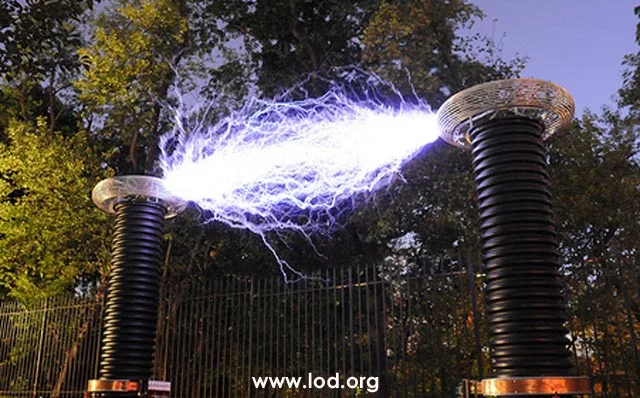Calling all Tesla fans! Electrical engineer Greg Leyh and his team at the Lightning on Demand organization (LOD) in California are raising the funds necessary to build the world's largest twin Tesla coils (ten stories high, about 120 ft/37 m) that will be capable of generating electric arcs more than 200 feet (60 m) long. Dubbed the "Lightning Foundry," the project currently consists of a working 1:12 scale prototype. When complete, a towering pair of coils will fill a football field-sized area with massive electric bolts that researchers hope will reveal some of the mysteries of this beautiful but deadly force.
Like the "juice" that flows through our home wiring, lightning is electricity, but it behaves very differently than the relatively low voltages we use to power our lives. When natural lightning is initiated, it inexplicably slices through the air as much as ten times more easily than smaller-scale electric arcs. Since previous research indicates that lab-generated electric arcs longer than 200 feet (60 m) begin to behave more like real lightning, Leyh and his team aim to generate even longer arcs in an effort to understand the physics behind this size-related property shift.
For those unfamiliar with the genius behind the technology Leyh's team is using, Nikola Tesla was a brilliant Serbian inventor who first came to America in 1884 and pioneered the use of alternating current (AC) in power distribution. Along with electricity and wireless power transmission, he was also fascinated with a phenomenon called resonance, the combination of carefully-timed small forces to form massive amounts of energy. His first resonant transformer circuit or Tesla coil (actually comprised of two coils, one surrounded by the other), was designed and built around 1891.

Tesla discovered that when AC built up in the primary coil of his device, it created a magnetic field capable of inducing current in the secondary coil. He then learned that he could make this induction happen more efficiently if the current flowing through both coils matched in their oscillation frequency. By converting low voltage and high current in the primary coil into high voltage and low current in the secondary coil, the whole unit acts like a transformer. The bigger the secondary coil, the greater the resultant voltage, which, when high enough, can shatter the surrounding air into charged ions that permit current flow. At that point, the accumulated energy is discharged in the form of a high-energy arc, standard issue in the labs of all mad scientists.
While awaiting completion funds for the behemoth version of the Lightning Foundry, Leyh's team is gleaning useful information from its functional scale prototype. Along with the luxury of being able to test out new design ideas, the group reports numerous instances of unexpected behavior from the device, including the wireless transmission of power over long distances, a key goal of Tesla's throughout his checkered career. Check out the LOD site if you'd like to play a role in this electrifying pursuit!






